Interview: The Misty Special 2020 – Talking Infection With V V Glass & Anna Savory
6th December 2020
Christmas and these dark, dark nights is the perfect time to enjoy a good ghost story – and we’ve got just the thing to give you that delicious chill down your spine with the new Misty Winter Special, which is out now!
Inside, you’ll find two spooky tales – first, there’s Home for Christmas, by Lizzy Boyle (Scream! & Misty) and David Roach (Anderson, Psi Division), who treat us to a ghostly home-invasion that reveals dreaded sins of the past! But here, we’re chatting to the talented team behind the tale Infection, Anna Savory (Tales from the Satanic Library) & V.V. Glass (Doctor Who), who’ve got a terrifying treat for you with a disturbing tale about how far people are expected to conform to societal standards no matter how warped the rules become!
BUY NOW >>
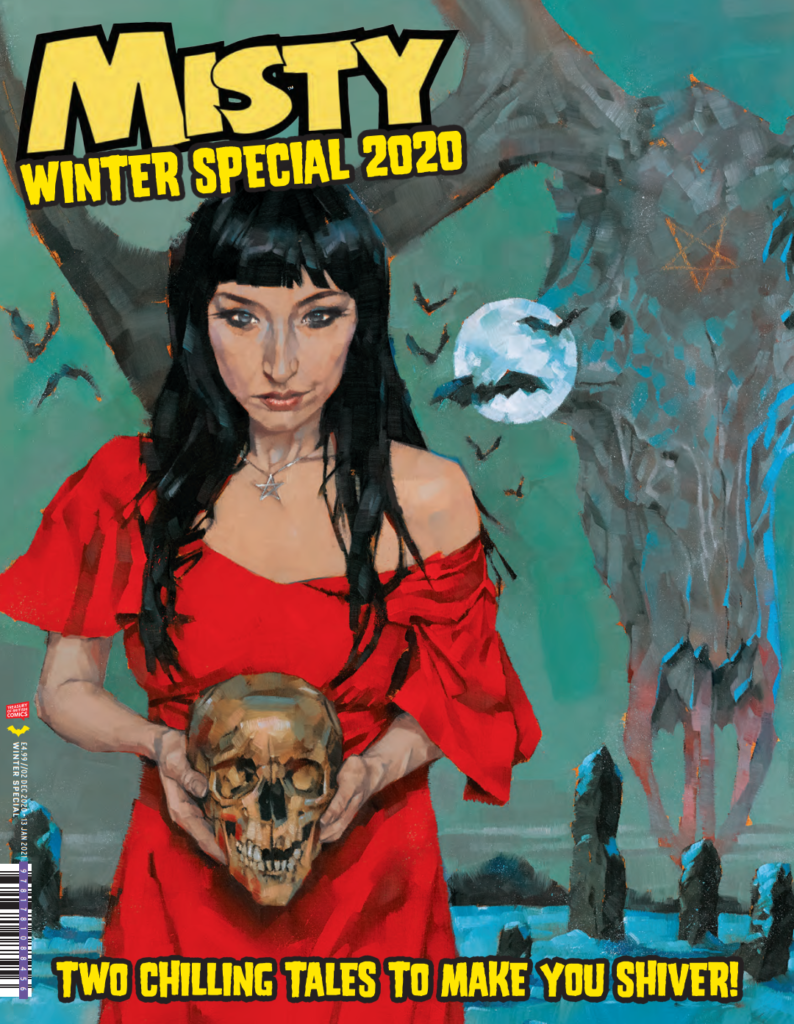
101 issues of Misty were published weekly from 1978 to 1980, giving British readers a comic aimed at young girls that chilled and thrilled. Sure, there were plenty of ghosts, ghouls, zombies and monsters but, perhaps more importantly, Misty also never shied away from the darkness of the world, punishing any mild fault or foible with damnation or worse. Oh no, this certainly wasn’t the girls comic of looking after your pony or of girls school high-jinks, this was a comic where nightmares ruled.
Misty was home to some incredible strips, with great writing, wonderful artwork, something that’s been carried on through the new stories in the Misty & Scream Specials we’ve published, and continues here in this new Misty Winter Special.
Now, let’s catch up with V V Glass and Anna Savory to talk all things infectious and nasty in Infection… they’ve taken the creative partnership very seriously here, answering mostly as a unit, the perfect synergy of writer and artist!
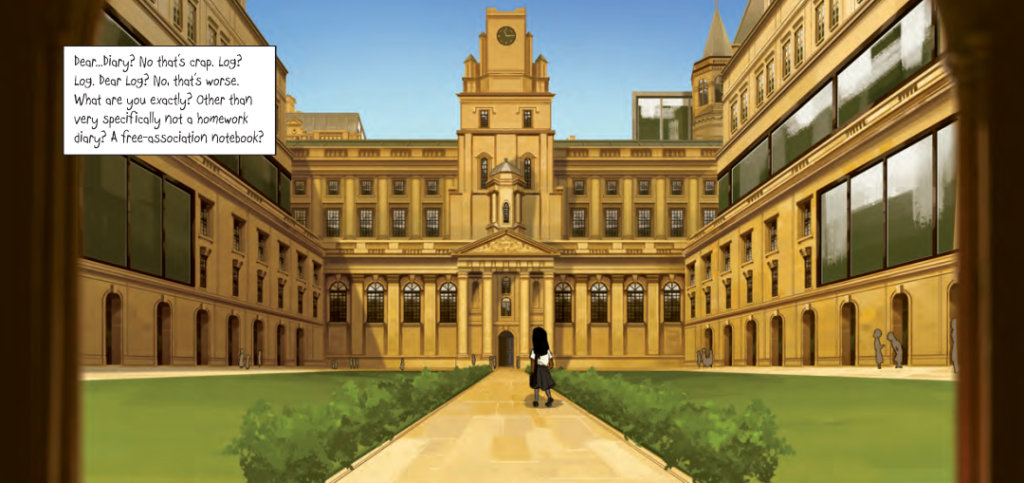
V V, Anna, your strip in the new Misty Winter Special is called Infection and described as, ‘a disturbing tale about how far people are expected to conform to societal standards no matter how warped the rules become.’
I suppose the first thing to ask is what is this one all about?
V V GLASS / ANNA SAVORY: It’s not girls’ school hi-jinks! But it’s not not not girls’ school hi-jinks either! You might call it ‘a chilling tale of conformity gone mad’ if you were absolutely determined to quote The Simpsons at every opportunity (we are).
It’s about Char Baker, who has just won a science scholarship to a prestigious girls’ public school and her efforts to adapt to her new surroundings while still maintaining her sense of self and sanity. The Marx Brothers are there, as is the spectre of class-bound tradition masquerading as modernity. No ponies, admittedly, but maybe some ghosts.
Given the title, is it something that came about thanks to the wonderful year that Covid has given us?
V V G / AS: Interestingly, not originally – although there is no getting away from the theme of contagion either in the strip or in life! We sketched out most of the plot before last Christmas, and a lot of it came from a seed for a ghost story Anna had written back in 2017, along with some framing themes and images from V and one name joke.
So we had everything greenlit and planned out a while before quarantine, but there’s a definite thematic similarity, and the majority of the actual writing was done in those first few months of lock-down in an atmosphere of entrapment and febrile national panic! So we think that pervades the text nicely!
We had quite a few conversations at the start about whether the pandemic was going to completely change the way we all thought about contagion and disease, and whether we’d written a pre-COVID story for post-COVID publication, but we don’t think it’s shaken out that way – it’s only very superficially about communicable disease (in the traditional sense…). But people will definitely see parallels between this story and everyone’s lived reality of the last nine months, especially (we hope!) in the interaction between contagion and authority, but none of it is an explicit statement. The author being dead, though, they can all have at it.
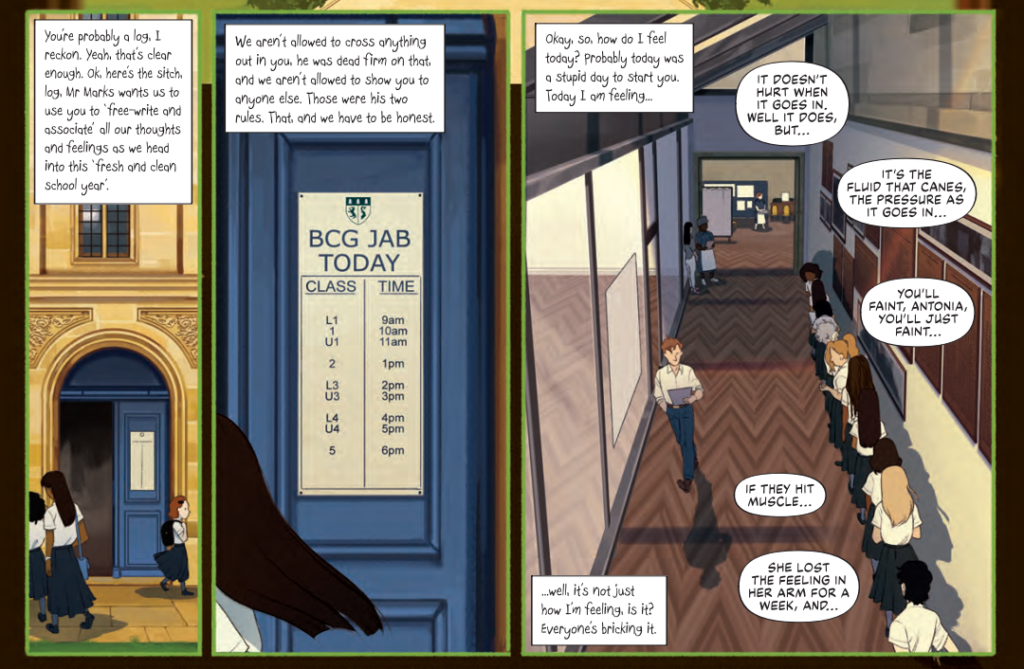
How did the strip come about – did you pitch to get it or were you contacted by the editor (Oliver Pickles) and, seeing as you’re collaborating on this as co-writers, how did the collaboration come about?
V V G / AS: Oliver! Apple of our inboxes. V did a strip for last year’s Tammy & Jinty Special (‘In the Cold Dark’ with Matt Gibbs), which was basically an archaeological ghost story. Oliver asked them to do something for this year’s Winter Misty off the back of that, and both of us have wanted to collaborate on something substantial for as long as we’ve known each other, so this was the perfect opportunity for that. Anna’s produced a lot for performance but hadn’t written for comics before, and V had adapted a lot for comics but not really written for them, so we could balance the creative load nicely to play to our strengths.
So, for example, Anna’s specifically very good at conveying the reality of being a teenage girl – with all the unpleasantness and social intricacies of that, as well as the anger – without losing a sense of plot momentum and humour, and V’s good at the kind of expressive implicative visual beats that are one of the main draws of comics.
V, you’ve worked with Rebellion a few times already, with the 13th Floor Special and the Tammy & Jinty Special. Anna, as far as I know (and forgive me if I’m wrong), this is your first comics work?
Anna Savory: Yes! You’re quite right. My first rodeo. But I’m a horror writer and performer so the genre at least was well within my wheelhouse. I used to tour (back when we could!) with an occult one-woman show about a library of cursed books I inherited.
Well, that explains your Twitter bio – ‘Comedian and writer. British Library by day, Satanic Library by night.’
AS: Oh yes. And I’ve worked a lot in the space where horror and comedy and feminism intersect (what a space!); developed work for The London Horror Festival; Folk Horror Cinema club; taken a comedy-horror showcase to The Latitude Festival with Robin Ince and Reece Shearsmith. I also write and perform a lot of ghost stories on the London storytelling circuit, but until now almost all of my horror work has been written – and usually performed. This is my first experience of writing a comic, which is why it was so valuable to collaborate with V, who is of course so brilliantly visual in their process and the way they think. I presume they got me in as a sort of horror and ghost story adviser, and also, I expect, an adviser on the casual cruelty of teenage girls, and then we just went from there.
With Infection, I’m assuming that it’s going to have the same tone of Misty strips of old, giving readers old and young a good chill down the spine?
V V G / AS: Hopefully! There are definitely moments throughout where we tried for that punch of experiencing something strange and unpleasant that you get from going through the old annuals. The other bonus of us collaborating is we could bring what we both value in horror to the story – Anna’s a folk horror champion, so she could focus on the deceptively mundane setting and character-based mounting tension you get in those stories, and V’s a big fan of unsettling uncanny work like PTSD Radio and A Field in England, so there’s a lot of using the familiar in unfamiliar ways coming from those influences. We like to think there’s a bit of an inheritance of the old strips’ comedy factor as well, there’s a good sense of humour in both adding to the atmosphere.
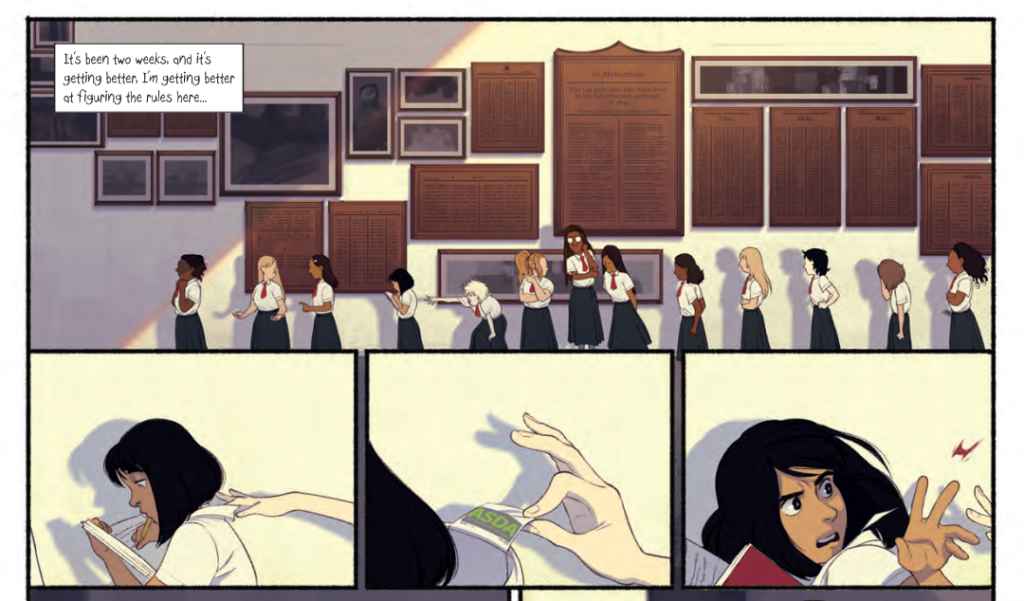
And, when thinking about the sorts of strange unpleasantness seen in Misty, would you agree that those sorts of horrors were far more psychological, far more affecting, than the more visceral horrors of something like the EC Comics.
V V G / AS: That’s very true, and there’s definitely a case to be made for eerie things sticking with you for longer, but we also think the two things aren’t necessarily at odds. This definitely isn’t gore and splatter, but there’s something about as visceral in the psychological horror here – as we mentioned before, the driving visual for this in terms of spook factor ended up being ordinary things made uncanny by context, and that’s really the core of psychological horror. So in that vein we’ve tried to isolate a few recurring motifs and images that go beyond the spooky and are just flat-out disturbing.
There’s always a little bit of hand-wringing that goes on with horror for kids, but I think there’s plenty of evidence out there that children do really enjoy a good scare, in whatever medium they get it. What is it, do you think, that appeals to younger readers with horror comics?
V V G / AS: We’ve done a fair amount of that hand-wringing privately actually. We don’t think either of us set out trying to pitch this very hard at a young audience; we both wrote something that we as adults found spooky, and presumed Misty readers would be intelligent and fear-loving enough to find it spooky too.
When we finished writing everything we did suddenly think ‘oh God, we hope this won’t actually traumatise anyone, is this okay for who it’s aimed at?’ But as you say, you have to give young readers credit, and the sort of people who are seeking out a horror comic know what they want, no sensitive readers are going to encounter this against their will. The saving grace, as well as part of the appeal, of horror comics (with the emphasis on comics) is you can engage with them at your own pace – you can spend as long as you need on a splash page or pack it in after a second if it’s too much. And the fact there is that more active relationship between reader and text is what makes good horror strips so effective, you have to make yourself make the story happen, by turning the page.
Horror is one of the most compelling genres for young readers, we think, and part of that is because it’s slightly illicit, which is always exciting. It’s something you grow up being told you aren’t old enough for – you can’t watch an 18 certificate film when you’re 12 – so part of what is so attractive is it makes you feel brave and mature when you choose to read it. And of course there’s a thrill in the idea you might not be able to handle it! Obviously it’s a cliché to say horror is a safe experience of things that would ruin your life if they happened to you in reality, but it’s true. It’s an exploration of things we’re told not to explore, which is especially appealing for young people.
I’m assuming that neither of you were reading Misty when it came out, so where did your awareness of the comic come from?
V V G / AS: We didn’t read them as they came to market, no, but weirdly we did both come across them quite young. Anna had a few copies in her garage as a teenager, which belonged to her uncle (proof of what you were saying about this transcending its intended audience). She was on a huge kitsch horror kick from the age of 14-18, but she actually couldn’t handle the sort of hard-core sleepover screenings her friends were into. Campy and creepy was right-up her alley, though! So Misty went with Amicus as part of her horror self-education, rather than Richard Laymon and Hostel.
And the nurse’s office at V’s primary school had a lot of the collections for some reason, and they read a lot of them while waiting to go to hospital there, so Misty is part of some fairly formative childhood memories (swab round the back of the eye socket). And actually, they were also too much of a coward for sleepover horror films back then, so horror comics were a sort of digestible onramp to being able to stomach the general body of horror media. Which, come to think of it, is another thing that makes Misty appealing to younger readers, that type of horror is manageable at that age.
And what did you think of the old Misty tales?
V V G / AS: Loved ‘em! They’re classic in the best possible sense, you understand the time they were produced for exactly when you read them, which is part of the point as we understand it. They’re hyper-relevant to their audience, from the character types and clothes, to the kinds of stories being told, which is something the new comics are pulling off as well. We hope that while we haven’t replicated them (because it’s 2020 now) we’ve managed to produce something close to them in spirit.
Where do you see this new Misty Winter Special appealing? Presumably, it’s a strip written and drawn with a teen+ reader in mind?
V V G / AS: Yes and no – for Anna’s part especially she’ll have an audience in the back of her mind as she writes, but we try not to write at an audience. Making something you, as an adult, think a teenager would like is going to end up feeling forced and condescending – especially with horror. As with comedy, you should go with whatever gets a reaction from you and trust you’ll find your audience on the same page. But that said, we wouldn’t be professionals if we didn’t hold them vaguely in mind, and hopefully, it’s a strip that taps into some very essential teenage themes and questions and fears.
In terms of the visuals, we did lean away from gore and the more hardcore horror ideas we had in order to keep it readable for the younger contingent of the teen-and-up readership, as much as for reasons of personal taste. And pseudo-Glen Keane cartoon art is basically appealing to all ages, so we didn’t choose to aim the style at any age-group in particular either.
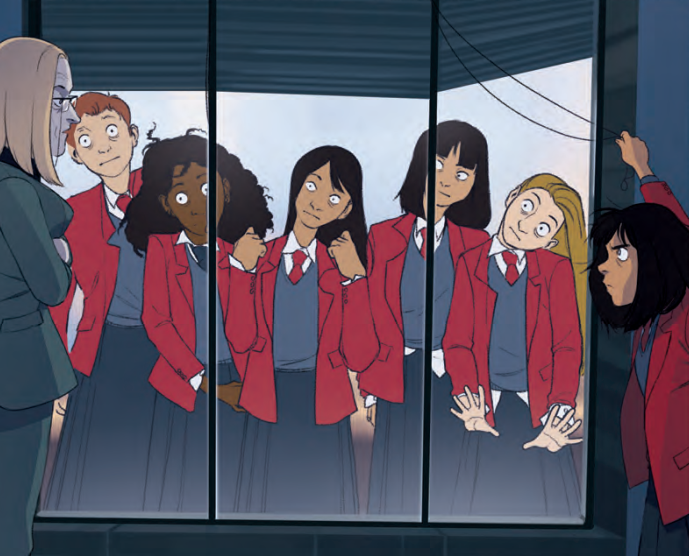
When talking of these comics, it’s easy to use the older descriptors of these as ‘girls’ comics. But even back then, comics such as Misty had many, many boys grabbing copies from their sisters and enjoying the great strips inside.
What was it that made these older strips and comics, ostensibly designed and marketed to girls in a time when there was a very defined boys and girls market for anything and everything, something special that crossed the gender boundaries in this way.
V V G / AS: It’s an interesting question. Horror is lucky in that it’s already a slightly niche genre, so it sort of transcends any additional classifications – you’ve already gone beyond the idea of neat clear-cut pony-club girls’ comics by having dark stories. And really the only thing demarcating girls’ and boys’ comics then was the worry on the part of the reader that they’d be mocked for reading the ‘wrong’ type, it’s not so much something built into the nature of the stories themselves. So boys, back in the day, might have felt less embarrassed reading their sisters’ horror comics, as opposed to romance or adventure strips, because there’s more shared ground in fear than other experiences, and it’s a more publicly defensible choice. Hopefully, it doesn’t need to be one now though.
And thinking about the traditions of these older comics and how they’re being brought back for new readers today, how do you visualise and hope the comics will develop?
V V G / AS: We’d like to see, on the one hand, more ongoing series and more anthologies with a shared theme or framing device from things like Misty – although that might just be our mutual love of Amicus talking. On the other hand, the strength of Misty and its sister comics is the shorter, disconnected stories – you can read them in any order, there’s no continuity, and none of the pressure for the creators of keeping one plot going over years of issues. So we wouldn’t want long-form strips to replace the more usual short story collections, it’d be great to have both running concurrently.
It’d also be great to have Misty et al. branch out as we go on, to have period pieces and genre work. There’s a temptation to have everything in comics like this be set in the current year (not that we’re an exception here), which can get wearing if it’s done too much. We think people overestimate how much kids and teens can only or only want to connect with stories set in their own lifetimes, but a lot of teenagers are hugely into fashion and media of the past, there’s no reason they wouldn’t get on with period pieces in horror too.
More generally, the current remit Rebellion’s got for these older comics – diversity and modernity – feels extremely welcome. Hopefully that stays a central tenet of these properties, it’s certainly one of the more rewarding things we kept in mind while writing for them.
V, one thing that’s particularly nice to see from artists is an idea of the process of putting together their pages. What process do you use for your art – is it digital, old-school pencil and ink, or somewhere in-between?
V V GLASS: Digital and old-school, digital trying to replicate old-school in fact. So I start with doing roughs in a notebook, and I’ll do the whole strip in one go so I can have a sense of how everything’s going to cohere, and go back and edit things where needed, (which, as I understand it, is what literally everyone does, but you never know, someone out there might thumbnail 10 pages at a time to keep a sense of mystery.)
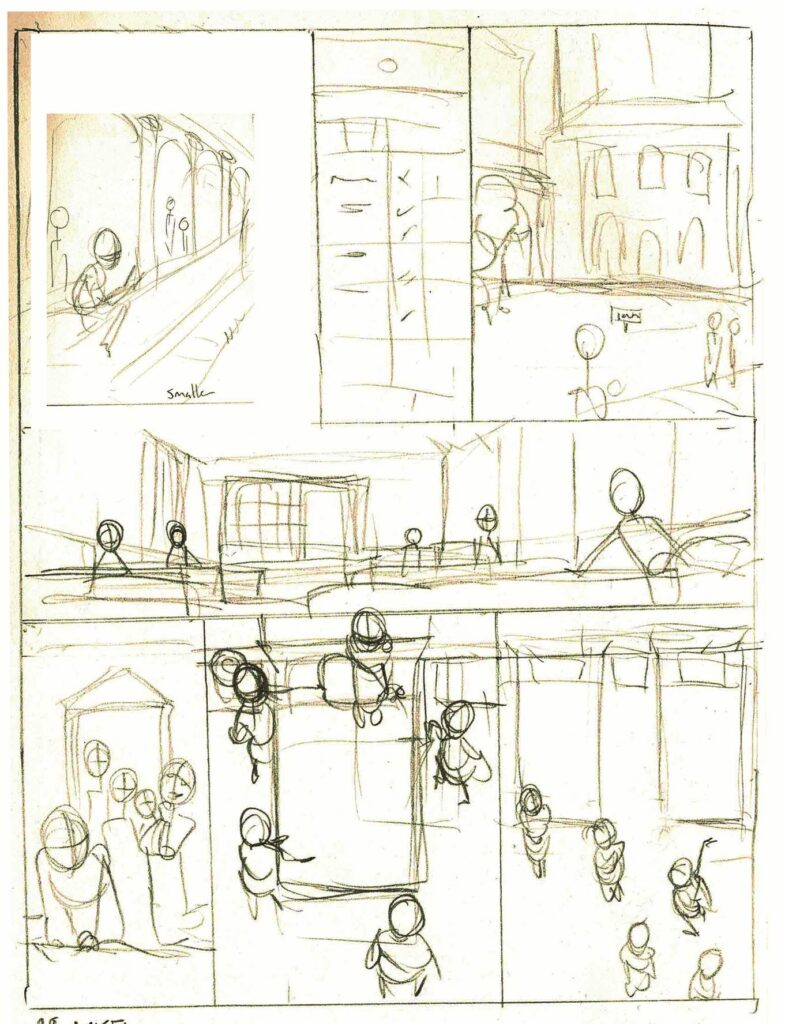
You can see the first stab at a page differs quite a lot from the final version, this stage is more about getting a basic idea of space and flow down quickly.
Then I scan everything and put each rough page on a full-size template in Photoshop, move things around so they use the space properly, and put panel borders on. That’s by far the most boring part of the whole process so it helps to get it out of the way early.
The next bit is a bit of a leap, but I go straight in and paint the backgrounds for all the pages, using the roughs as a guide for where the figures will go when I draw them in. It’s easier to keep a flow going by doing essentially 36 matte paintings in a row rather than cutting between painting buildings and drawing people, and it helps with sorting out the perspective in the figure-drawing stage too. I’ll have a lot of reference images on hand for this bit.
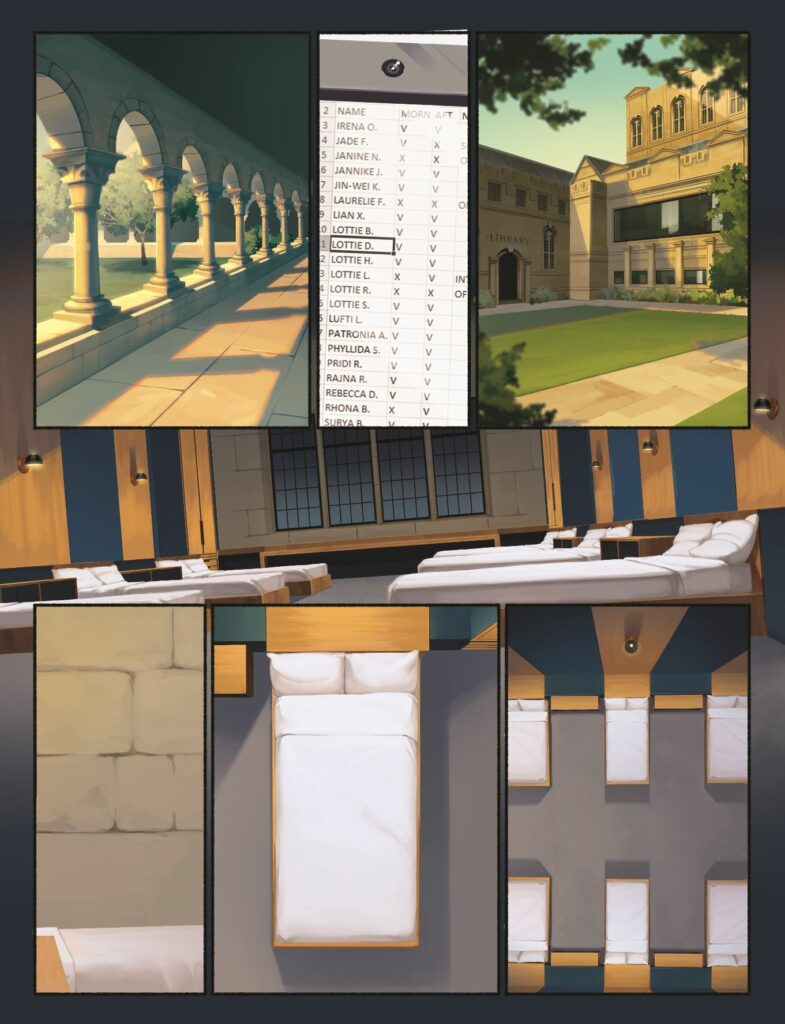
So then the rest of the process is pretty standard – pencilling the figures over the top of the backgrounds, inking them and then putting on flat colour and shade. I normally leave the figures flat, obviously, that helps distinguish them against the backgrounds, but I will add in a bit more rendering or texture on close-ups etc.
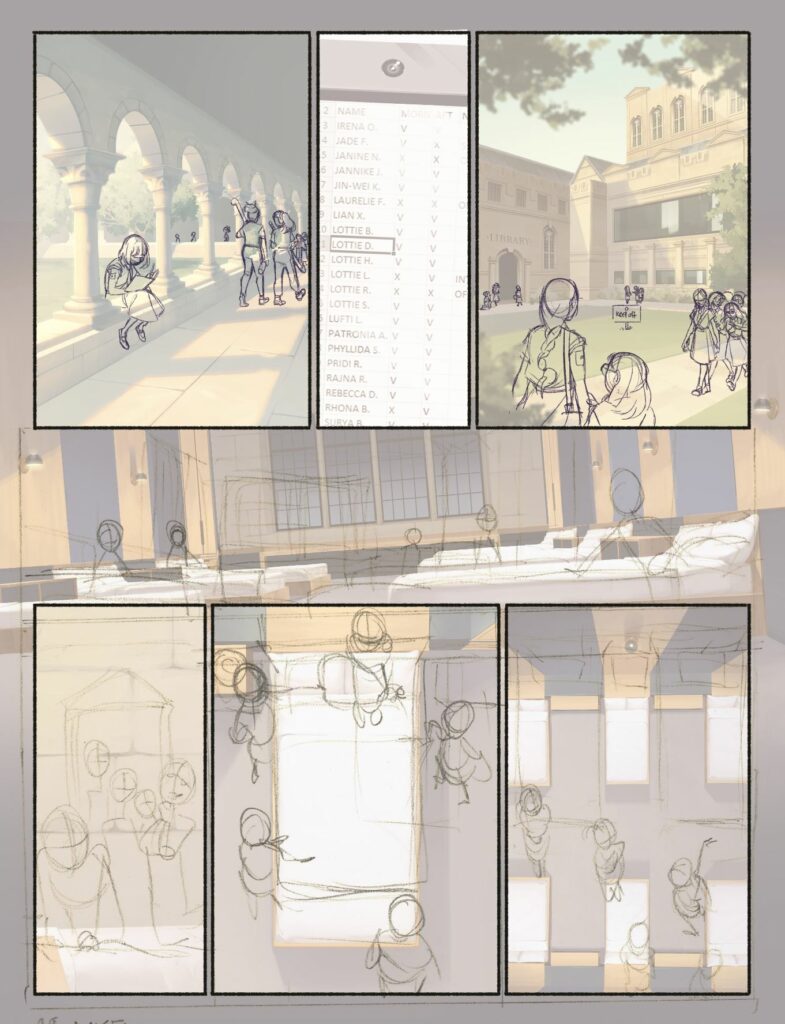
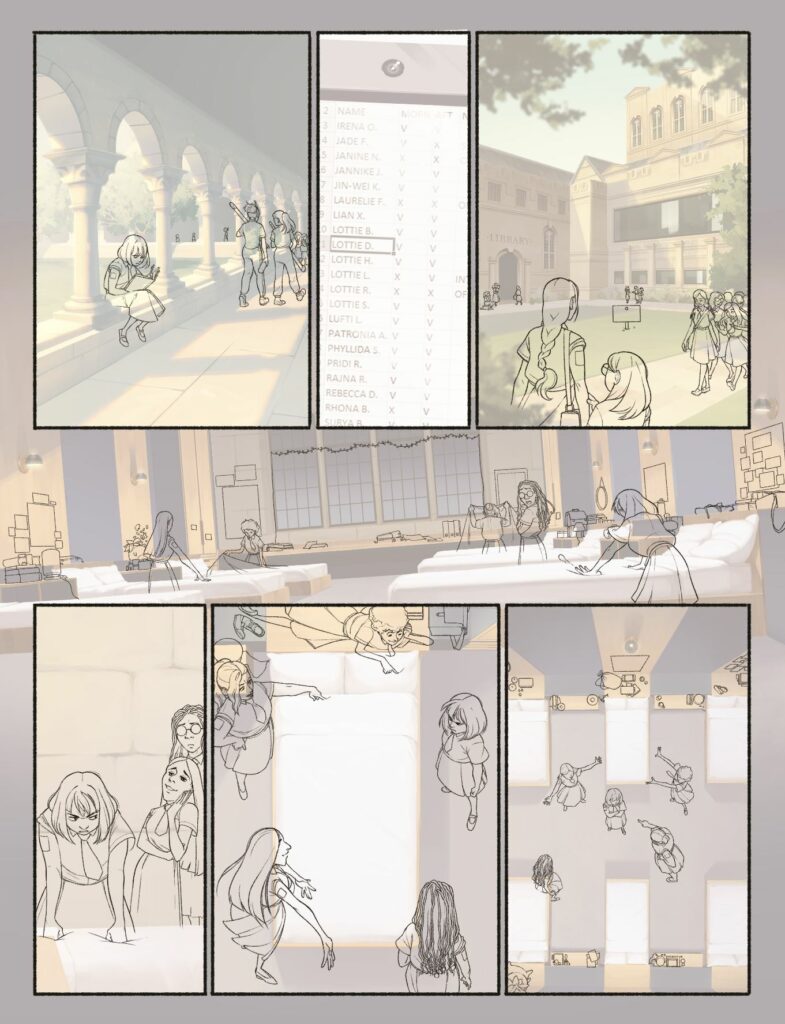
And then the final stage is tweaking the colours on the whole page so the palettes of different panels don’t clash, and neatening everything up.
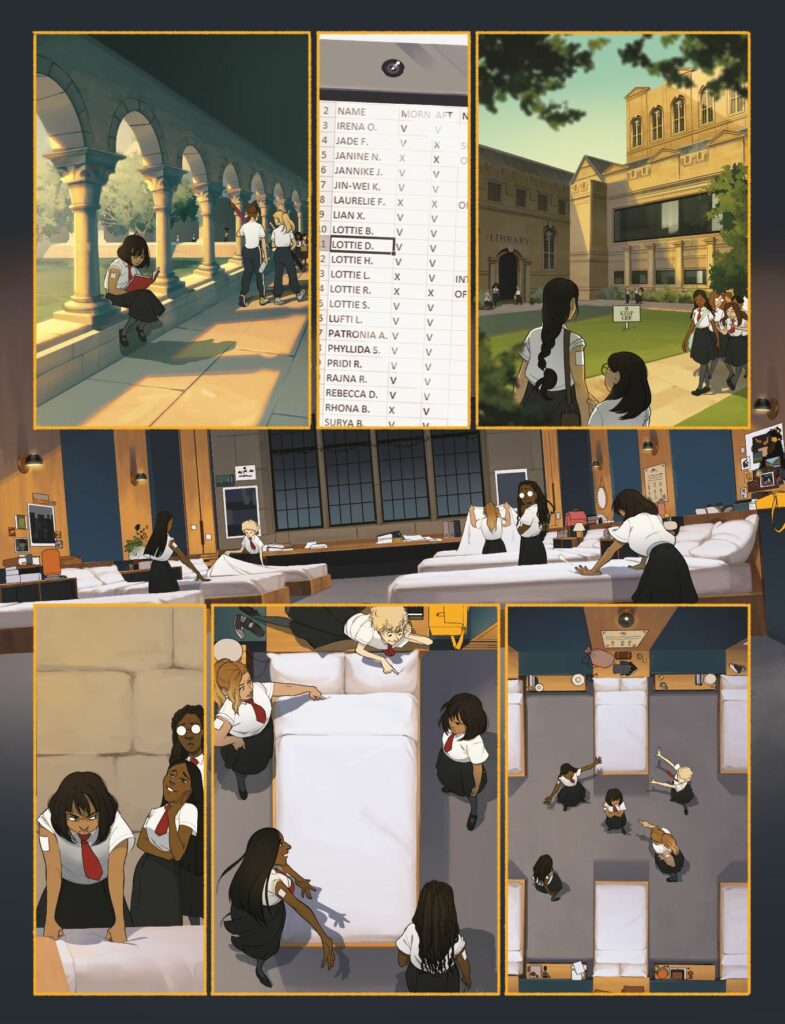
Finally, what can we look forward to from both of you for the coming year, both Rebellion and beyond?
V V G / AS: Anna’s currently working on a ‘feminist ghost story collection cum memoir’ (the agent’s term, not hers) which is taking up most of her time. V’s working on The Last Witch, an ‘unpleasant fairytale’ with Boom! Studios (out 2021), which is taking up all of their time. And we’re very slowly working on a collab miniseries which we can’t talk about yet, but put very broadly it’s Hammer Horror meets Scooby Doo.
Hammer Horror meets Scooby Doo? Zoinks!
Well, thank you so much to V V and Anna for talking to us about Infection – you can find it in The Misty Winter Special, out on 2 December wherever comics are sold and from the 2000 AD web shop. And for more from those involved in The Misty Winter Special, check out the latest Thrill Cast!

